Dicalcin inhibits fertilization through its binding to a glycoprotein in the egg envelope in Xenopus laevis
- PMID: 20299459
- PMCID: PMC2865274
- DOI: 10.1074/jbc.M109.079483
Dicalcin inhibits fertilization through its binding to a glycoprotein in the egg envelope in Xenopus laevis
Abstract
Fertilization comprises oligosaccharide-mediated sperm-egg interactions, including sperm binding to an extracellular egg envelope, sperm penetration through the envelope, and fusion with an egg plasma membrane. We show that Xenopus dicalcin, an S100-like Ca(2+)-binding protein, present in the extracellular egg envelope (vitelline envelope (VE)), is a suppressive mediator of sperm-egg interaction. Preincubation with specific antibody greatly increased the efficiency of in vitro fertilization, whereas prior application of exogenous dicalcin substantially inhibited fertilization as well as sperm binding to an egg and in vitro sperm penetration through the VE protein layer. Dicalcin showed binding to protein cores of gp41 and gp37, constituents of VE, in a Ca(2+)-dependent manner and increased in vivo reactivity of VE with a lectin, Ricinus communis agglutinin I, which was accounted for by increased binding ability of gp41 to the lectin and greater exposure of gp41 to an external environment. Our findings strongly suggest that dicalcin regulates the distribution of oligosaccharides within the VE through its binding to the protein core of gp41, probably by modulating configuration of oligosaccharides on gp41 and the three-dimensional structure of VE framework, and thereby plays a pivotal role in sperm-egg interactions during fertilization.
Figures

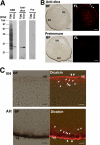
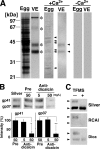
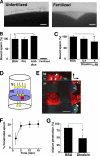


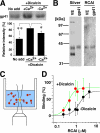

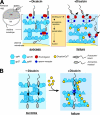
Similar articles
-
Dicalcin, a zona pellucida protein that regulates fertilization competence of the egg coat in Xenopus laevis.J Physiol Sci. 2015 Nov;65(6):507-14. doi: 10.1007/s12576-015-0402-7. Epub 2015 Sep 29. J Physiol Sci. 2015. PMID: 26420688 Free PMC article. Review.
-
Fertilization competence of the egg-coating envelope is regulated by direct interaction of dicalcin and gp41, the Xenopus laevis ZP3.Sci Rep. 2015 Aug 5;5:12672. doi: 10.1038/srep12672. Sci Rep. 2015. PMID: 26243547 Free PMC article.
-
Protein-Carbohydrate Interaction between Sperm and the Egg-Coating Envelope and Its Regulation by Dicalcin, a Xenopus laevis Zona Pellucida Protein-Associated Protein.Molecules. 2015 May 22;20(5):9468-86. doi: 10.3390/molecules20059468. Molecules. 2015. PMID: 26007194 Free PMC article. Review.
-
Gamete interactions in Xenopus laevis: identification of sperm binding glycoproteins in the egg vitelline envelope.J Cell Biol. 1997 Mar 10;136(5):1099-108. doi: 10.1083/jcb.136.5.1099. J Cell Biol. 1997. PMID: 9060474 Free PMC article.
-
Analysis of a sperm surface molecule that binds to a vitelline envelope component of Xenopus laevis eggs.Mol Reprod Dev. 2010 Aug;77(8):728-35. doi: 10.1002/mrd.21211. Mol Reprod Dev. 2010. PMID: 20568299
Cited by
-
Structural and rheological properties conferring fertilization competence to Xenopus egg-coating envelope.Sci Rep. 2017 Jul 18;7(1):5651. doi: 10.1038/s41598-017-06093-3. Sci Rep. 2017. PMID: 28720818 Free PMC article.
-
Dicalcin suppresses invasion and metastasis of mammalian ovarian cancer cells by regulating the ganglioside-Erk1/2 axis.Commun Biol. 2023 Oct 6;6(1):1015. doi: 10.1038/s42003-023-05324-w. Commun Biol. 2023. PMID: 37803211 Free PMC article.
-
Dicalcin, a zona pellucida protein that regulates fertilization competence of the egg coat in Xenopus laevis.J Physiol Sci. 2015 Nov;65(6):507-14. doi: 10.1007/s12576-015-0402-7. Epub 2015 Sep 29. J Physiol Sci. 2015. PMID: 26420688 Free PMC article. Review.
-
Fertilization competence of the egg-coating envelope is regulated by direct interaction of dicalcin and gp41, the Xenopus laevis ZP3.Sci Rep. 2015 Aug 5;5:12672. doi: 10.1038/srep12672. Sci Rep. 2015. PMID: 26243547 Free PMC article.
-
Extracellular Ca2+ Is Required for Fertilization in the African Clawed Frog, Xenopus laevis.PLoS One. 2017 Jan 23;12(1):e0170405. doi: 10.1371/journal.pone.0170405. eCollection 2017. PLoS One. 2017. PMID: 28114360 Free PMC article.
References
-
- Yanagimachi R. (1994) in The Physiology of Reproduction (Knobil E., Neill J. D. eds) pp. 189–317, Raven Press, New York
-
- Primakoff P., Myles D. G. (2002) Science 296, 2183–2185 - PubMed
-
- Hoodbhoy T., Dean J. (2004) Reproduction 127, 417–422 - PubMed
-
- Litscher E. S., Wassarman P. M. (2007) Histol. Histopathol. 22, 337–347 - PubMed
-
- Clark G. F., Dell A. (2006) J. Biol. Chem. 281, 13853–13856 - PubMed
Publication types
MeSH terms
Substances
LinkOut - more resources
Full Text Sources
Other Literature Sources
Miscellaneous

